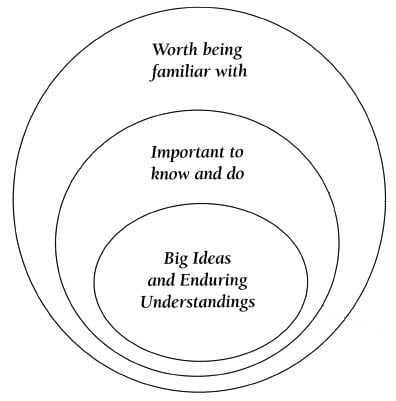Big Ideas
The ideas that drive you and your course
What is it?
Big ideas are concepts, debates, or theories that are at the core of a discipline and that you, as a teacher, can choose to put at the core of your course.
Writing is action – Accounting is the language of business – We study wildlife to understand ourselves
What drives you to do what you do as a teacher, a researcher, an academic? What are your core beliefs about what you study? These are your big ideas, the drivers of what you do. The importance of these big ideas to your understanding is reason enough to pass them on to your students — this is your opportunity to shape how they make connections between the many moving parts of your discipline as well as between your discipline and the world they are moving through every day. What an opportunity!
Just as big ideas drive your study, they can also drive your pedagogy. In fact, when big ideas drive the choices you make as a teacher, your course develops a cohesion that allows students to find meaning and connection between its many pieces. Think of your big ideas as thesis statements that frame and organize the course content for the sake of making meaning.
The term “big ideas” comes from Understanding By Design, which lists five major qualities of big ideas:
- Provide a focusing conceptual “lens” for any study
- Provide breadth of meaning by connecting and organizing many facts, skills, and experiences; serving as the linchpin of understanding
- Point to ideas at the heart of expert understanding of the subject
- Require “uncoverage” because its meaning or value is rarely obvious to the learner, is counterintuitive or prone to misunderstanding
- Have great transfer value; applying to many other inquiries and issues over time — “horizontally” (across subjects) and “vertically” (through the years in later courses) in the curriculum and out of school (UBD, 68)

Big ideas are like linchpins, the small but essential tool that connects a wheel to its axle and allows everything to move forward.
How Can I Use Big Ideas in My Course?
The term “big ideas” comes from Understanding by Design (UBD), an approach to designing academic courses that values “backward design,” which means starting the design of your course with a big idea and working backward through learning outcomes, assessments, activities and lessons. Through this process, the big ideas become integrated into the course at multiple levels and stages. Students then work toward uncovering the big idea and its complexity by progressing through the course and using the idea to see the connections between everything they are doing.
The challenge for you as a teacher (aka designer of your students’ learning) is to choose a few big ideas and allow this focus to help you make decisions about what to prioritize as you build your course. You likely have big ideas both about the content of your course and about pedagogy — both can and should guide you as you build your course. Remember that big ideas are as much about what you leave out as about what you include. Choosing those that are most important to you are your way of establishing learning priorities and not trying to teach the whole field in one go.
Note that your big ideas are yours, and that students may be bringing their own big ideas when they enter your class – particularly in upper-level courses. Students will have their own frames for understanding and prioritizing content, their own approaches to the material and ways of integrating it into what they already know and value. Your big idea has connected everything for you. Invite students to make their own connections. Then invite their big ideas into your class to expose multiplicity — there are many big ideas we could apply to the same material.

Questions and Considerations
A big idea of Understanding By Design is that knowing where you are going helps you get there: Backward Design. This approach is particularly popular and effective for online learning, which typically requires a teacher to do more pre-semester design work than a face-to-face class. Some struggle with this approach because it’s hard to know where you are going before you know who is going with you (your students) and what they want to do (their big ideas). These are valid concerns. Start with your big ideas, but let them be flexible. Big ideas should be flexible, and they should change over time. Build space into your course for this change and for students to bring their big ideas.
You may be someone who does not start with a big idea. Perhaps you had an assignment that worked really well last time you taught this course and you’ve decided you’d like to build around it. That’s great! In all likelihood, this assignment has a big idea (or many) in it, and you will uncover that idea as you build. You do not have to start with the big idea, but don’t dismiss it too quickly. Students will reach better understanding if there is something there to help them connect the materials to each other and the context around them.
Research Foundations
Kirkpatrick, M., Aboutabl, M., Bernstein, D., & Simmons, S. (2015). Backward Design: An Integrated Approach to a Systems Curriculum. Proceedings of the 46th ACM Technical Symposium on Computer Science Education (SIGCSE ’15), 30-35. New York, NY: ACM.
Tsai, C. (2015). Applying the Backward Design Planning Process to Teach English as a Foreign Language Reading Comprehension Strategies Instruction. Modern Journal of Language Teaching Methods. Vol. 5, No. 4.
Wiggins, G., & McTighe, J. (2005). Understanding by Design (2nd ed.). Alexandria, VA: Association for Supervision and Curriculum Development.
Watch
Grant Wiggins, co-author of Understanding by Design, explains the framework and the role of Big Ideas.
